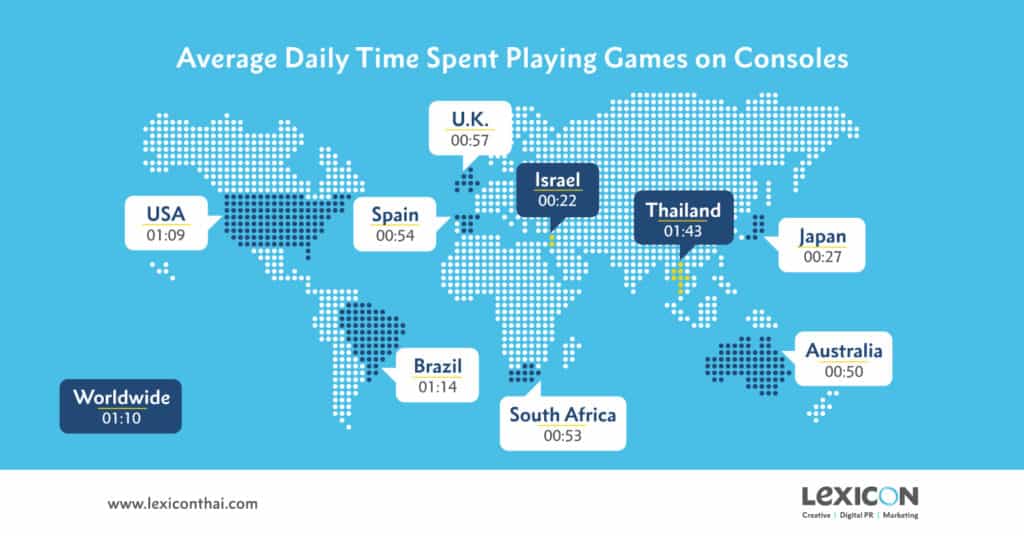This is Part 9 in our ongoing series of blogs based on the Digital 2020 Report from Hootsuite and We Are Social. The report is jam-packed with facts and figures, which we’ve investigated in depth to bring you the stories behind the statistics. Parts 1 through 8 are linked here:
Part 1 – Exploring Our Digital Planet
Part 2 – Good News for Marketers: The Digital World is Expanding
Part 3 – Where Will People See Your Content in 2020?
Part 4 – Sleepless in Siam
Part 5 – How to Survive in an E-Commerce Red Ocean
Part 6 – A Region Primed to Explode (online)
Part 7 – Winning Over the Digital Crowd
Part 8 – Reality Anxiety and the Paradox of Trust
As a leading digital marketing agency in Bangkok, we’ve spent a lot of time in this series talking about the various aspects of our rapidly expanding digital world. But there’s one very important area that we haven’t touched yet: gaming.
81% of internet users aged 16 to 64 – a huge portion of the world’s 4.5 billion netizens – regularly play video games on various devices. The mobile phone has quickly become the most popular device for gaming, but consoles are still widely used, especially in Thailand. While Thais are big on mobile gaming too, they spend more time on average playing console games than their counterparts in any other country.
Although advertising in video games has been around for just about as long as video games have existed, they remain somewhat underutilized by marketers. In this blog, we’ll take a close look at the online gaming world, both on the world stage and within Thailand, with an eye toward the exciting ways that brands can give their digital marketing campaigns some extra life.
Console gaming
Worldwide, internet users spend an average of an hour and ten minutes each day using video game consoles. As in most other digital realms, however, Thailand is well above the norm – and is in fact the world leader in terms of total time spent.

Thai netizens love gaming on consoles, spending a full 33 minutes (or 47%) longer than the world average every day. Surprisingly, the typical person in Japan – the birthplace of Nintendo – doesn’t seem all that keen on consoles. On the other hand, some Japanese gamers are the most hardcore of them all: 8% report having spent more than 15 consecutive hours playing games.
This brings us to an important point about consoles: Certain demographics play them way more than the average gamer. Males aged 18 to 35 are the most likely to log long hours playing on consoles. And, some 57% of those in this category even report aspirations of becoming professional gamers.
While console gamers are something of a niche market, they still represent a massive potential audience of people with similar interests who are all in the same place – in other words, a digital marketing agency’s dream. If only there was a way to reach them …
In-game advertising: Get in the game, literally
Product placement in video games has actually been around for quite a while.
The first instance of in-game advertising can be traced back to 1978 when the microcomputer game Adventure Land featured a plug for the upcoming Pirate Adventure.

FIFA – the world’s most popular series of sports game – has had in-game advertising since 1994.

Then vs Now: Same tactics, better graphics
Now, in-game advertising is everywhere. And, it’s not just sports games that are taking advantage of this tactic.

Advertising is all but ubiquitous in the real world, so it naturally follows that the gaming world would follow suit. While many of the ads in today’s games often look like the simple billboards, banners, and signs that we see in everyday life, they are actually quite sophisticated.
Some in-game ads are static, which means they are integrated into the game at the design stage. These are often part of the game’s storyline and function in much the same way product placements do in movies. The main difference is that, these being video games, players can often actually interact with the ads. Static ads are a great way for brands to reach a global audience – global among players of the game, at least.
Other in-game ads are dynamic, which means they can be placed in the game and updated or modified in real time, even after the game has been released. Dynamic ads function similarly to banner ads on websites. They can also be geo-targeted, making them ideal for time-sensitive advertising to players in specific countries, regions, cities, and even neighborhoods.
With Thailand leading the way in console gaming, companies could see some serious return on investment with these forms of video game advertising. Thanks to the versatility of dynamic ads, even local brands could see a boost.

Mobile gaming: Reach noobs and vets of all ages
While console gaming is extremely popular among certain people, only about 25% of all internet users actually engage in it. Mobile gaming, on the other, is much more widespread: 69% of internet users aged 16 to 64 regularly play games on their mobile devices.
Mobile gaming is responsible for nearly half of the total gaming market’s estimated yearly revenue of over $148 billion. As mobile games are more accessible than console games, a wider range of people play them. Unlike console games, men and women play mobile games in nearly equal numbers: 52% and 48% respectively.
Somewhat surprisingly, a smaller percentage of Thai internet users play mobile games when compared to the global population: 67% vs 69%. But as the Digital 2020 Report notes, Thailand has reached 134% mobile phone connectivity, meaning that some people own multiple devices. These extra devices might very well be skewing the numbers artificially downward. For example, a person who owns two phones might only play games on one of them, while using the other for work purposes only.
At any rate, mobile gamers in Thailand represent a massive market of potential customers. Mobile games are the fifth most used app category in Thailand, behind only messaging, social media, video streaming, and map apps.
As we’ve discussed elsewhere, successful marketing is all about meeting your customers where they are. Since so many Thais are playing games on their phones, brands could stand to win big if they invest in getting into those games.
Research from Newzoo suggests that mobile gamers are more likely than non-gamers to “buy products from brands whose ads they enjoy”. Moreover, they are “far likelier to have a positive attitude toward global brands”.
Several well-known brands have already seen success advertising in popular mobile games. In the EA Sports game Madden NFL Mobile, players can complete Gatorade challenges to earn coins, XP points, and stamina boosts.

Food and beverage titan Nestlé partnered with developer King, creator of over 200 games including the wildly popular Candy Crush Saga series, to run in-game video ads. Players can choose to watch the videos in exchange for an extra life, a booster, or currency. The ads worked very well: 99.5% were watched to the end, and 3% of players who saw the ads actually clicked through.
Pizza Hut ran a highly successful location-based ad campaign in China with the game King of Glory. (Outside of China, it’s called Arena of Valor, and, incidentally, it’s the most popular game in Thailand in terms of active users.) Whenever a player came near a Pizza Hut location, they were invited inside to play with fellow users. In the first 20 days of the campaign, 100,000 players accepted these invitations. Throughout the campaign, Pizza Hut sold more than 150,000 King of Glory special edition meal sets. This total represented a 900% return on investment.
Starbucks took full advantage of the Pokémon GO craze in 2016 by making about 12,000 of their shops PokéStops or Gyms. They also created the Pokémon GO Frappuccino to sell to the players flocking to Starbucks locations.
Brands looking to try a similar video game marketing strategy in Thailand may find particular success by making themselves visible in the following titles:
For those seeking an even bolder approach to market to online gamers, there’s one more avenue we have yet to explore.
Advergames: Be the game you wish to see in the world
Some brands go above and beyond working within existing games, and actually create their own. These advergames – as they’re often called – have actually been around since the late 1970s, when some companies made their own commercial arcade games. In the intervening years between then and now, some brands also created their own console and computer games. But advergames have become much more popular in recent history, thanks to the rise of mobile gaming.
While these games are much more expensive and labor-intensive to produce than ads for existing games, they do have some significant benefits. A popular game will have much greater staying power than a traditional ad campaign, which may be forgotten as soon as it ends. Of course, users are well aware that an advergame is really just an ad – but if it’s fun and compelling enough, they won’t care. Moreover, the game’s icon will remain on users’ home screens and remind them of the brand every time they see it.
A prime example of a successful advergame is Chipotle Scarecrow, which was buoyed by the promotion generated from its accompanying short film. In just four days after its release, the game had been downloaded 250,000 times in the US alone.

Fortune favors the bold
Video games have long been a bastion for innovation. We’ve come a long way from Pong – the first-ever video game created in 1958, which featured a simple scoreboard, a center line, two small lines to represent paddles, and a single-pixel dot to represent the ball. Today’s games immerse players in entire fantastical worlds, with intricate storylines where people from around the world come to interact and compete with each other. Mobile games, which are currently less sophisticated than their console brethren, have nevertheless found ingenious ways to keep people coming back for more, with delightfully addictive gameplay and enticing rewards systems.
As we have seen, many brands have been able to successfully infiltrate these digital worlds to connect with new customers. And just like with all other forms of advertising, the biggest winners are often the best storytellers. When brands can seamlessly insert themselves into a game – not only not disrupting the player experience, but actually enhancing it – the rewards can be huge.
As we have also seen, Thais on average tend to be big gamers. While businesses in Thailand have earned plenty of success by marketing on the usual social media platforms, they would be wise to consider expanding their reach into video games as well. By adding a new dimension of visibility and engagement, this move toward video game marketing could give brands the boost they need in order to level-up.